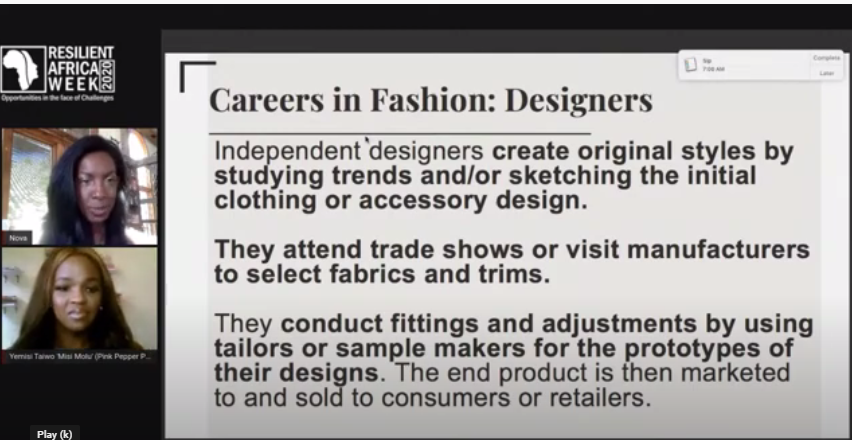Fashion: Brickstone Africa sponsored Post Covid-19 Discussion Series organized by The African Catalyst with the objective of bringing to light the various opportunities available post-covid-19 era currently not highlighted by the media.
The host for this session was Oluyemisi “Misi Molu” Fajimolu Taiwo, CEO Pink Pepper Production. While Nova Lorraine, founder of Raine Magazine was the Guest Speaker.
The Livestream was sponsored by Brickstone Africa
@brickstone.africa
The sole purpose of this session is to highlight and discuss the immediate and long-term impact of Covid-19 on Africa’s Fashion and Design Industry.
Stylists provide fashion advice; choose and coordinate outfits for models in photo shoots or actors in television and film. They can work for individuals and fashion houses. Independent designers create original styles by studying trends and/or sketching the initial clothing or accessory design.
They attend trade shows or visit manufacturers to select fabrics and trims. They conduct fittings and adjustments by using tailors or sample makers for the prototypes of their designs. The product is then marketed to and sold to consumers or retailers.
Clothing manufacturers will collect all the necessary materials and some also approve the quality of the materials. Manufacturers can do all or some of the following: pattern making, cutting, sewing, printing, packaging, folding, and shipping. Full-service manufacturers do everything that comes with producing a line.
Independent designers create original styles by studying trends and/or sketching the initial clothing or accessory design. They attend trade shows or visit manufacturers to select fabrics and trims. They conduct fittings and adjustments by using tailors or sample makers for the prototypes of their designs. The product is then marketed to and sold to consumers or retailers.
Clothing manufacturers will collect all the necessary materials, and some also approve the quality of the materials. Manufacturers can do all or some of the following: pattern making, cutting, sewing, printing, packaging, folding, and shipping. Full-service manufacturers do everything that comes with producing a line.
A typical example of a type of manufacturer is a CMT, a cut and sew factory. Materials sourced by designers are sent to the factory. The CMT will then cut and sew the garments and ship them directly to the designer or consumer.

KEY TAKEAWAYS:
The guest speakers recommended the following:
1. Fashion labels using mostly African materials and productions.
2. Creation of fashion business hubs: The Assembly Hub is a great example of a platform that supports creative talent in Africa fostering entrepreneurs and companies to innovate the face of fashion in a rapidly changing marketplace.
3. Start-ups fashion in Africa need to conduct intensive market research of competitors and have a solid sense of how the market might change.
4. For any business to maintain steady growth, it is important to source for a reliable manufacturer to meet the demand of the customer.
Watch Livestream Replay
QUESTION AND ANSWER SESSION
The webinar saw several questions pertaining to fashion design framework. See some of the answers below:
Q: In the fashion life circle, it seems like most designers find it hard to break out of that phase with lots of rejections. Therefore, what is the best model to build your brand in order to mitigate against this tough phase?
A: If you believe in your products, then It’s important to always maintain a resilient attitude. In other words, look forward to Yes’s and don’t give up.
Q: As a bridal fashion designer in Lagos looking to scale up; one of the looming challenges for me is fabric sourcing; considering they are mostly imported from Asia. It is hard to keep production costs down which impedes our ability to be competitive. What do you think can be done about this?
A: If textiles are a big issue, spend time on researching smaller manufacturers and creating a strategic partnership with them.
Q: For startups especially for upcoming streetwear designers; acceptance can be a problem because of our culture and norms, and then there’s the issue of pricing. How can one deal with all these without feeling discouraged?
A: Give people a reason to spend more. Get creative on social media and share your story. Stories are very important. They give something to the customer to fall in love with. Therefore, you should never ignore it.

